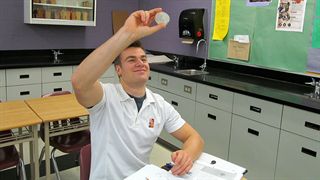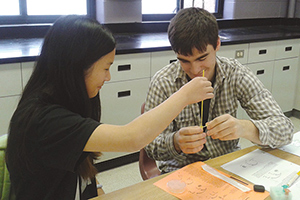
The 12th grade biology class of Hamilton District Christian High in Ancaster, Ontario, has successfully introduced a gene from bio-luminescent jelly fish into E. coli bacteria. The E. coli expressed the gene and produced green fluorescent protein, which causes the bacteria to glow a brilliant green color under ultraviolet light.
This is the third year students have conducted this experiment as part of their unit on molecular genetics. As part of this unit, the class studies the mechanics of gene expression as well as the social, ethical, and legal considerations of biotechnology. Examples of applications of genetic modification in industry and agriculture are also discussed.
Teacher Kim Oppertshauser got the idea for the experiment from a workshop at a conference of the Science Teachers Association of Ontario. “There is a laboratory kit made by BioRad that contains most of the consumable parts of the experiment,” she said. “So, if you have a water bath, an incubator, and some crushed ice, you are set.”
 “The students learn how easy it is to make a transgenic organism (an organism that contains DNA from a different organism),” said Oppertshauser. “Before they start, the idea of moving DNA from one organism to another in order to control their traits is the stuff of movies like Jurassic World. But within a morning, they were able to take DNA from a jellyfish and put it into a bacteria, giving the bacteria the ability to glow green under UV light, a trait originally possessed by the jellyfish.”
“The students learn how easy it is to make a transgenic organism (an organism that contains DNA from a different organism),” said Oppertshauser. “Before they start, the idea of moving DNA from one organism to another in order to control their traits is the stuff of movies like Jurassic World. But within a morning, they were able to take DNA from a jellyfish and put it into a bacteria, giving the bacteria the ability to glow green under UV light, a trait originally possessed by the jellyfish.”
Genetic modifications are used in agriculture, food production, medical therapies, animal cloning, pharmaceutical production, and forensics, but “this ability also carries with it all sorts of ethical and moral questions: for example, designer babies,” said Oppertshauser.
“The students are proud of the authenticity of the experience,” said Oppertshauser. “When they realized that their technique had been successful, they went and got the vice-principal and brought her to our class to show her their work. They all took pictures on their phones of their results and posted them on social media.” The experiment has become a regular part of Grade 12 biology, which is also taught by Jake Plantinga.